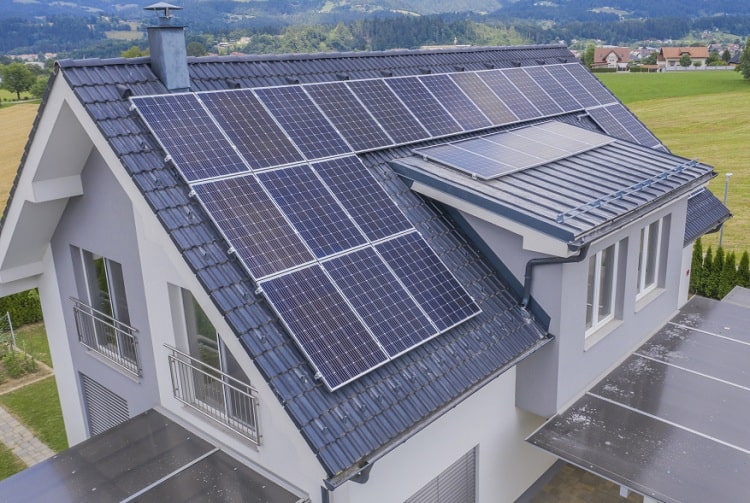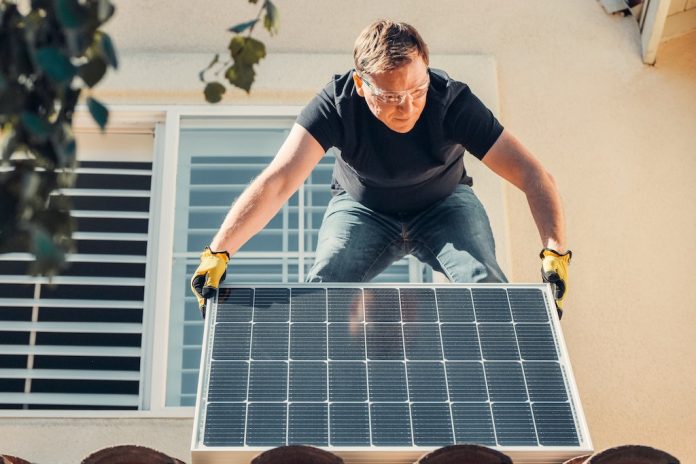A solar power plant is your way of using the sun as an unlimited alternative source of energy. Having decided to install a solar power plant, you will be able to:
- save on electricity by up to 70%,
- reduce dependence on tariff increases,
- receive income from the sale of their electricity to the general grid at the “green tariff”,
- insure against blackouts, and have a backup power source.
The use of alternative energy sources is your contribution to the future. Installing a 20 kW solar station on the roof of your house is equivalent to 300 planted trees.
Do-it-yourself solar panels are a bad idea. Because the panel requires certain skills from the installer, experience in installation is also important to achieve maximum results.
If the installation is not done in the optimal location for this, you will receive less energy and, accordingly, your home costs will increase.
Our company aion.solar will be able to help you choose the best option and professionally install solar panels in a place convenient for you.

Features of installing solar panels
A large number of factors affect the generation of SES. One of the main ones is the installation itself. Where to install, at what angle, on the roof or the ground?
Key factors in installation
#1. Locality
The place should be without shadows, around at least trees, tall buildings, fences, etc. It is necessary to anticipate as much as possible the appearance of any objects that can prevent the rays from reaching your future solar panel.
#2. The level of insolation in the region
This is an indicator of the amount of solar radiation. The higher it is, the more the station can generate. Different areas require a different number of panels to achieve the same result.
#3. Orientation to the sunny side
The ideal option is a station facing south. This option is not always possible, for example, in the case of a west-east gable roof. But you should choose the most optimal location.
If we consider the ground structure, then everything is simple with orientation. Experienced installers will easily calculate the correct direction.
The question lies in something else: is there a necessary free space?
Our company makes specialist visits to facilities. This is a great opportunity to evaluate your plot, house, and all possible location options with a professional eye.
#4. Angle of inclination
The optimal angle is considered to be 35-45°. Using such data, 97-100% of the specified output power will already be achieved.
How to connect solar panels
Solar panels produce energy that cannot directly power electrical appliances. The conversion of the necessary voltage is carried out with the help of inverters connected to a circuit between the main consumer and the panel.
There are three main schemes for connecting solar batteries.
#1. Offline connection
The scheme of connecting solar batteries is most often used in areas with no centralized power supply network. Includes high-capacity rechargeable batteries. They function according to the principle of energy accumulation during daylight hours. The produced energy is sent to the power consumption network when the level of lighting is insufficient.
#2. Backup connection
Installation scheme and method of connecting a solar battery, suitable for use in the presence of a centralized power supply using an alternating current network. The backup system is used as a backup option, which is used in the event of an emergency. Power outages are not uncommon for country houses and cottages, so many consumers resort to additional options for obtaining light and heat.
#3. Serial connection
The scheme of connecting solar batteries of a country house involves excessive energy generation and its subsequent entry into the network. The method is quite popular and is used in the electrification of private houses.
Installation
According to the listed schemes of connection to the battery, solar batteries are attached to a special structure that ensures the resistance of photocells to the influence of adverse atmospheric influences and creates a specific angle of inclination. A similar design is offered in several versions:
- Inclined. Optimal for installation on pitched roofs.
- Horizontal. The construction, the installation of which is carried out on flat roofs.
- Freestanding. Solar batteries that fit under any type of roof.
Where is the best place to install solar panels
Many people believe that mounting solar panels on the roof of houses and buildings is the best place. Indeed, a convenient place, as open as possible to the sun, but there are some nuances in the installation.
For batteries to generate maximum energy, they need to be installed in the most lit place available, and this is not always the roof. Very often the best place for installation is an open land plot. Carefully choose a place so that there is no shade from trees or neighboring buildings, because if the polycrystalline panels can still cope with the blackout, then the monocrystalline ones will slow down the work a lot, which is undesirable.
If you prefer to mount solar panels on roofs or vertical surfaces of buildings, keep the distance between them so that the rows do not obscure each other.
Installing solar panels in a private house is an opportunity to save on hot water in the summer, as well as support your heating system in the winter. Installing solar panels does not provide for the ability to simply screw a panel to the roof and run two wires to the electrical panel of the house.
Installing solar panels on the roof is also the best solution since it is the roof that is most convenient to catch the maximum solar energy. The layout of your home must be done in such a way as to maximize solar gain. For example, there should not be any additional devices on the roof.
What solar stations consist of?
The configuration of solar stations is different. The standard kit includes:
- solar panels;
- inverter for solar panels;
- battery;
- aluminum or galvanized structures for installation;
- special cables and connectors.
Installing solar panels on the roof of an apartment building, as well as a balcony or loggia has its characteristics. Recommended polycrystalline batteries, which maintain efficiency even in cloudy weather. Balconies and loggias are ideal if they face the south sunny side. It can also be installed on the east and west sides, but the productivity will be lower.
When thinking over a miniature station on a balcony or loggia, consider not only the direction of the world but also the required area for equipment. You can install panels from the outside, but only if there is no glazing. If the balcony is on the top floor, then installation on the roof is possible. Installing solar panels in a private house or apartment has a lot of advantages, and everyone wins the planet, the state, and the owner of the station.
Solar energy is an environmentally friendly, inexhaustible source of energy, and it is wonderful that our country motivates citizens to use it. Choose high-quality modern equipment for solar stations on our website, and invest in your future and the future of our planet.













